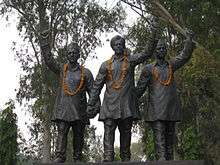Shivaram Rajguru
| Shaheed Shivaram Rajguru | |
|---|---|
 Statue of Bhagat Singh, Rajguru and Sukhdev | |
| Born |
24 August 1908 Khed, Pune, Bombay Province, British India |
| Died |
23 March 1931 (aged 22) Lahore, British India, (now in Punjab, Pakistan) |
| Movement | Indian Independence movement |
shaheed Shivaram Hari Rajguru' (24 August 1908 – 23 March 1931) was an Indian revolutionary from Maharashtra, known mainly for his involvement in the assassination of a British Raj police officer.
Rajguru was born in a Marathi Deshastha Brahmin family at Khed, near Pune, in what was then British India. He grew up in Khed and his family had always harboured strong anti-British, pro-nationalist sentiments. By his late teens was a member of the Hindustan Socialist Republican Association, who wanted India to be freed from British rule by any means necessary. He believed that ferocity against oppression was far more effective against British rule than the nonviolent civil disobedience preferred by Mahatma Gandhi.
Rajguru became a colleague of Bhagat Singh and Sukhdev, and took part in the assassination of a British police officer, J. P. Saunders, at Lahore in 1928. Their actions were to avenge the death of Lala Lajpat Rai who had died a fortnight after being hit by police while on a march protesting the Simon Commission. The feeling was that Rai's death resulted from the police action, although he had addressed a meeting later.[1][2]
The three men and 21 other co-conspirators were tried under the provisions of a regulation that was introduced in 1930 specifically for that purpose.[3] All three were convicted of the charges and hanged on 23 March 1931. They were cremated at Hussainiwala at the banks of the Sutlej river in the Ferozepur district of Punjab.
His birthplace of Khed has since been renamed as Rajgurunagar in his honour. Rajguru Market, a shopping complex at Hisar, Haryana, was named in his honour in 1953.
See also
References
- ↑ Sawhney, Simona (2012). "Bhagat Singh: A Politics of Death and Hope". In Malhotra, Anshu; Mir, Farina. Punjab Reconsidered: History, Culture, and Practice. Oxford University Press. p. 380. ISBN 978-0-19807-801-2. doi:10.1093/acprof:oso/9780198078012.003.0054.
- ↑ Nair, Neeti (May 2009). "Bhagat Singh as 'Satyagrahi': The Limits to Non-violence in Late Colonial India". Modern Asian Studies. Cambridge University Press. 43 (3): 649–681. JSTOR 20488099. doi:10.1017/s0026749x08003491. (Subscription required (help)).
- ↑ Dam, Shubhankar (2013). Presidential Legislation in India: The Law and Practice of Ordinances. Cambridge University Press. p. 44. ISBN 978-1-10772-953-7.
Further reading
- Noorani, Abdul Gafoor Abdul Majeed (2001) [1996]. The Trial of Bhagat Singh: Politics of Justice. Oxford University Press. ISBN 0195796675.